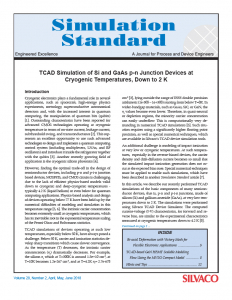TCAD Simulation of Si and GaAs p-n Junction Devices at Cryogenic Temperatures, Down to 2 K
Introduction
Cryogenic electronics plays a fundamental role in several applications, such as spacecraft, high-energy physics experiments, metrology, superconductive astronomical detectors and, with the increased interest in quantum computing, the manipulation of quantum bits (qubits) [1]. Outstanding characteristics have been reported for advanced CMOS technologies operating at cryogenic temperature in terms of on-state current, leakage current, subthreshold swing, and transconductance [2]. This represents an excellent opportunity to use such advanced technologies to design and implement a quantum computing control system (including multiplexers, LNAs, and RF oscillators) and introduce it inside the refrigerator together with the qubits [3]. Another recently growing field of application is the cryogenic silicon photonics [4].
However, finding the optimal trade-off in the design of semiconductor devices, including p-n and p-i-n junction based devices, MOSFETs, and CMOS circuits is challenging due to the lack of efficient physics-based models valid down to cryogenic and deep-cryogenic temperatures&typically 4.2 K (liquid helium) or even below for quantum computing applications. Physics-based analysis and design of devices operating below 77 K have been held up by the numerical difficulties of modeling and simulation in this temperature range [5, 6]. The intrinsic carrier concentration becomes extremely small at cryogenic temperatures, which has its inevitable root in the exponential temperature scaling of the Fermi-Dirac and Boltzmann statistics.
TCAD simulations of devices operating at such low temperatures, especially below 50 K, have always posed a challenge. Below 50 K, carrier and ionization statistics develop sharp transitions which cause slower convergence. As the temperature (T) decreases, the intrinsic carrier concentration (ni) dramatically decreases. For example, the silicon ni which at T=300K is around 1.5e+10 cm-3, at T=10K becomes 1.2e-267 cm-3, and at T=4.2K ni= 2.7e-678 cm-3 [3], lying outside the range of IEEE double precision arithmetic (1e-308 – 1e+308) starting from below T=8K. In wider-bandgap materials, such as GaAs, SiC, or GaN, the ni values become even lower. Therefore, in quasi-neutral or depletion regions, the minority carrier concentration can easily underflow. This is computationally very demanding in numerical TCAD simulations [5]. Such situation requires using a significantly higher floating point precision, as well as special numerical techniques, which are available in Silvaco’s TCAD device simulation tools.



